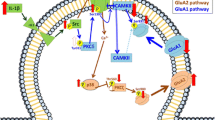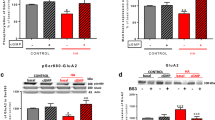Abstract
Hyperammonemia is considered the main factor responsible for the neurological and cognitive alterations found in hepatic encephalopathy and in patients with congenital deficiencies of the urea cycle enzymes. The underlying mechanisms remain unclear. Chronic moderate hyperammonemia reduces nitric oxide-induced activation of soluble guanylate cyclase and glutamate-induced formation of cGMP. NMDA receptor-associated transduction pathways, including activation of soluble guanylate cyclase, are involved in the induction of long-term potentiation (LTP), a phenomenon that is considered to be the molecular basis for some forms of memory and learning. Using an animal model we show that chronic hyperammonemia significantly reduces the degree of long-term potentiation induced in the CA1 of hippocampus slices (200% increase in control and 50% increase in slices of hyperammonemic animals). Also, addition of 1 mM ammonia impaired the maintenance of non-decremental LTP. The LTP impairment could be involved in the intellectual impairment present in chronic hepatocerebral disorders associated with hyperammonemia.
Similar content being viewed by others
REFERENCES
Shih, V. E. 1978. Urea cycle disorders and other congenital hyperammonemic syndromes. Pages 362–386, The Metabolic Basis of Inherited Disease, McGrawHill, New York.
Msall, M., Batshaw, M. L., Suss, R., Brusilow, S. W., and Mellitis, E. D. 1984. Neurologic outcome in children with inborn errors of urea synthesis. Outcome of urea cycle enzymopathies. N. Eng. J. Med. 310:1500–1505.
Michalak, A., Knecht, K., and Butterworth, R. F. 1997. Hepatic encephalopathy in acute liver failure: role of the glutamate system. Adv. Exp. Med. Bio. 420:35–44.
Hermenegildo, C., Montoliu, C., Llansola, M., Muñoz, M. D., Gaztelu, J. M., Miñana, M. D., and Felipo, V. 1998. Chronic hyperammonemia impairs the glutamate-nitric oxide-cyclic GMP pathway in cerebellar neurons in culture and in the rat in vivo. Eur. J. Neurosci. 10:3201–3209.
Marcaida, G., Miñana, M. D., Burgal, M., Grisolía, S., and Felipo, V. 1995. Ammonia prevents activation of NMDA receptors in rat cerebellar neuronal cultures. Eur. J. Neurosci. 7:2389–2396.
Izquierdo, I. 1991. Role of NMDA receptors in memory. Trends Pharmacol. Sci. 12:128–129.
Madison, D. V., Malenka, R. C., and Nicoll, R. A. 1991. Mechanisms underlying long-term potentiation of synaptic transmission. Ann. Rev. Neurosci. 14:379–397.
Boulton, C. L., Southam, E., and Garthwaite, J. 1995. Nitric oxide-dependent long-term potentiation is blocked by a specific inhibitor of soluble guanylyl cyclase. Neuroscience 69:699–703.
Bliss, T. V. P., and Gardner-Medwin, A. R. 1973. Long-lasting potentiation of synaptic transmission in the dentate area of the unanaesthetized rabbit following stimulation of perforant path. J. Physiol. (Lond) 232:357–374.
Bliss, T. V. P., and Lomo, T. 1973. Long-lasting potentiation of synaptic transmission in the dentate area of the anaesthetized rabbit following stimulation of perforant path. J. Physiol. (Lond) 232:331–356.
Bliss, T. V. P., and Collingridge, G. L. 1993. A synaptic model of memory: long-term potentiation in the hippocampus. Nature 361:31–39.
Azorín, I., Miñana, M. D., Felipo, V., and Grisolía, S. 1989. A simple animal model of hyperammonemia. Hepatology 10:311–314.
Miñana, M. D., Marcaida, G., Grisolía, S., and Felipo, V. 1995. Prenatal exposure of rats to ammonia impairs NMDA receptor function and affords delayed protection against ammonia toxicity and glutamate neurotoxicity. Neuropathol. Exp. Neurol. 54:644–650.
Nicoll, R. A., and Alger, B. E. 1981. A simple chamber for recording from submerged brain slices. J. Neuroci. Methods 4:153–156.
Matsuyama, S., Namgung, U., and Routtenberg, A. 1997. Long-term potentiation persistence greater in C57BL/6 than in DBA/2 mice: predicted on basis of protein kinase C levels and learning performance. Brain Res. 763:127–130.
Grover, L. M., and Teyler, T. J. 1990. Two components of long-term potentiation induced by different patterns of afferent activation. Nature 347:477–479.
Malenka, R. C., Lancaster, B., and Zucker, R. S. 1992. Temporal limits on the rise in postsynaptic calcium required for the induction of long-term potentiation. Neuron 9:121–128.
Anwyl, R. 1989. Protein kinase C and long-term potentiation in the hippocampus. TiPS 10:236–239.
Colley, P. A., Sheu, F. S., and Routtenberg, A. 1990. Inhibition of Protein Kinase C Blocks Two Components of LTP Persistence, Leaving Initial Potentiation Intact. J. Neurosci. 10:3353–3360.
Gianotti, C., Nunzi, M. G., Gispen, W. H., and Corradetti, R. 1992. Phosphorylation of the presynaptic protein B-50 (GAP-43) is increased during electrically induced long-term potentiation. Neuron 8:843–848.
Grover, L. M., and Teyler, T. J. 1995. Different mechanisms may be required for maintenance of NMDA receptor-dependent and independent forms of long-term potentiation. Synapse 19:121–133.
Pasinelli, P., Ramakers, G. M., Urban, I. J., Hens, J. J., Oestreicher, A. B., de-Graan, P. N., and Gispen, W. H. 1995. Longterm potentiation and synaptic protein phosphorylation. Behav. Brain Res. 66:53–59.
Chen, S. J., Sweatt, J. D., and Klann, E. 1997. Enhanced phosphorylation of the postsynaptic protein kinase C substrate RC3/ neurogranin during long-term potentiation. Brain Res. 749:181–187.
Wang, J. H., and Kelly, P. T. 1995. Postsynaptic injection of Ca2+/CaM induces synaptic potentiation requiring CaMKII and PKC activity. Neuron 15:443–452.
Felipo, V., Grau, E., Miñana, M. D., and Grisolia, S. 1993. Hyperammonemia decreases protein-kinase-C-dependent phosphorylation of microtubule-associated protein 2 and increases its binding to tubulin. Eur. J. Biochem. 214:243–249.
Kosenko, E., Kaminsky, Y., Grau, E., Miñana, M. D., Marcaida, G., Grisolía, S., and Felipo, V. 1994. Brain ATP depletion induced by acute ammonia intoxication in rats is mediated by activation of the NMDA receptor and of Na+/K+-ATPase. J. Neurochem. 63:2172–2178.
Grau, E., Marcaida, G., Montoliu, C., Miñana, M. D., Grisolía, S., and Felipo, V. 1996. Effects of Hyperammonemia on Brain Protein Kinase C Substrates. Metab. Brain Dis. 11:205–215.
Miñana, M. D., Felipo, V., Wallace, R., and Grisolía, S. 1988 High ammonia levels in brain induce tubulin in cerebrum but not in cerebellum. J. Neurochem. 51:1839–1842.
Author information
Authors and Affiliations
Rights and permissions
About this article
Cite this article
Muñoz, MD., Monfort, P., Gaztelu, JM. et al. Hyperammonemia Impairs NMDA Receptor-Dependent Long-Term Potentiation in the CA1 of Rat Hippocampus In Vitro. Neurochem Res 25, 437–441 (2000). https://doi.org/10.1023/A:1007547622844
Issue Date:
DOI: https://doi.org/10.1023/A:1007547622844




